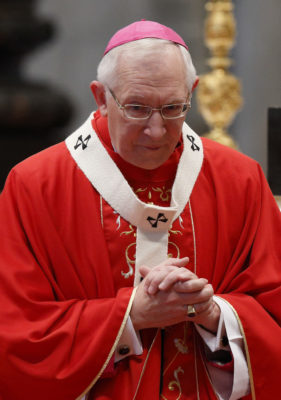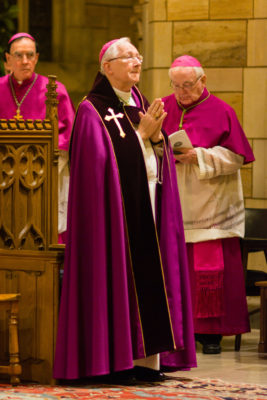May 9, 2017
Hartford Archdiocese announces comprehensive pastoral plan
REGIONAL
Staff report

HARTFORD, Conn. – On Sunday, May 7, Archbishop Leonard P. Blair and the Office of Pastoral Planning of the Archdiocese of Hartford announced a comprehensive pastoral plan that reconfigures the 212 parishes of the Archdiocese in Hartford, Litchfield and New Haven counties.
The merging and closing of the original 212 parishes will result in a total of 127 parishes in the archdiocese as of June 29, 2017.
According to the archdiocese’s May 7 press release, the announcement comes as the result of a two-year pastoral planning effort involving careful, thoughtful and prayerful consideration and wide consultation about the dramatic changes of the last half century, which continue today, and which have a major impact on the life of the church.
The goal is to ensure a more viable and sustainable future for parishes; better pastoral care and spiritual well-being for people and priests alike; and a revitalized sense of mission on the part of everyone to be a more active and welcoming community of faith in keeping with what Pope Francis calls “missionary discipleship.”

Archbishop Leonard P. Blair of Hartford, Conn., walks to his seat after receiving a pallium from Pope Francis during a Mass marking the feast of Sts. Peter and Paul in St. Peter’s Basilica at the Vatican June 29, 2014. (CNS file photo/Paul Haring)
To understand the plan, the difference between a parish and a church must be kept in mind, the press release states. The former refers principally to the people, the latter to a building. Effective June 29, of the 212 parishes, 68 will remain as they are, and 26 will close. The remainder will be reconfigured by the merging of two or more parishes into one parish with one or more church buildings, the continued use of which will be subject to local determination over time.
The fact that a parish is closing does not necessarily mean that its church building will be totally closed. It means that regularly scheduled Masses will no longer be celebrated there. As the pastoral process continues, new uses for buildings will be considered.
“The pastoral planning is intended to bolster discipleship and spiritual vitality. In essence, it’s about people, not buildings. These buildings might be used as ministry centers, pastoral offices, and housing. Selling the buildings will be considered if these options are not viable,” said Father James Shanley, vicar of pastoral planning.
Father Shanley said if a parish with savings is closed or a church building is sold, the money “will follow the people” to their newly-formed parish.
Archbishop Blair has assigned a name to each of the newly-created parishes. In April, he asked people to participate in the “Saints for Tomorrow” survey, which was published on the official website of pastoral planning, StewardsforTomorrow.org. Almost 1,000 people responded with potential names for newly formed parishes. A church building always retains the name by which it was dedicated, even if it is now part of a newly formed parish with a different name that embraces all the church buildings that are now part of it.
Priests have been assigned to the newly-merged parishes based on their experience and talents, with a view to what will best serve parishioners in a given community.
Among the factors that contributed to the need for reorganization are the following:
- Shifts in demographics, economic conditions, and urban and suburban development;
- In the last 50 years, Sunday Mass attendance in the Archdiocese has declined from 395,000 to 123,500, a decline of nearly 70 percent; this is matched by a decline in baptisms and church weddings;
- As is generally the case in the United States, there were not only fewer church weddings, but also fewer ordinations to the priesthood; since 1965, the total number of active priests in the archdiocese has dropped from 535 to 186, a decrease of 65 percent;
- Financial sustainability – A number of parishes are finding it increasingly difficult to maintain aging buildings with fewer active parishioners and fewer financial resources to meet their obligations.
Archbishop Blair acknowledged that people resist change, but said with the proper leadership they can come not only to understand and accept it, but even embrace it. He pointed to several successful mergers that have already occurred as part of the pastoral process over the past year. In January 2016, for example, St. Augustine in North Branford merged with St. Monica in Northford and became the Parish of St. Ambrose; more recently, two churches in the North End of Hartford merged to become St. Justin-St. Michael Parish.
“People are sometimes resistant at first, but over time they come together as one family of faith, and the result is greater unity and new vitality to various forms of parish life and outreach,” Archbishop Blair said. “The restructuring of parishes is meant to strengthen the church’s mission by generating new enthusiasm and greater resources to foster the spiritual and liturgical life of a community, as well as its merciful outreach to what Pope Francis calls the ‘spiritual, moral and material destitution’ of so many in the world today.”

Archbishop Leonard P. Blair prays during the vespers service at St. Thomas Seminary in Bloomfield, Conn., Dec. 15, 2013 the eve of his installation as the fifth archbishop of the Archdiocese of Hartford. (CNS file photo/Bob Mullen)
By implementing the pastoral plan, the archbishop said he hopes that the vision of Pope Francis for the church will be better fulfilled in the Archdiocese of Hartford. “We are all missionary disciples,” the pope wrote, and there is a need to “review and renew our parishes…, to bring them nearer to people, to make them environments of living communion and participation, and to make them completely mission-oriented.”
“I hope people will realize,” said Archbishop Blair, “that the purpose of pastoral planning is not only about ensuring a more sustainable future for them; it’s also about a future in the church for their children and grandchildren.
“My hope and prayer is that we will be revitalized by a new generation of young Catholics who believe and practice their faith, and who hear and respond generously to God’s call, whether in marriage and family life, or as priests and religious sisters or brothers,” he said.
For more information about pastoral planning in the Hartford Archdiocese, visit StewardsForTomorrow.org.


 Facebook
Facebook Youtube
Youtube
